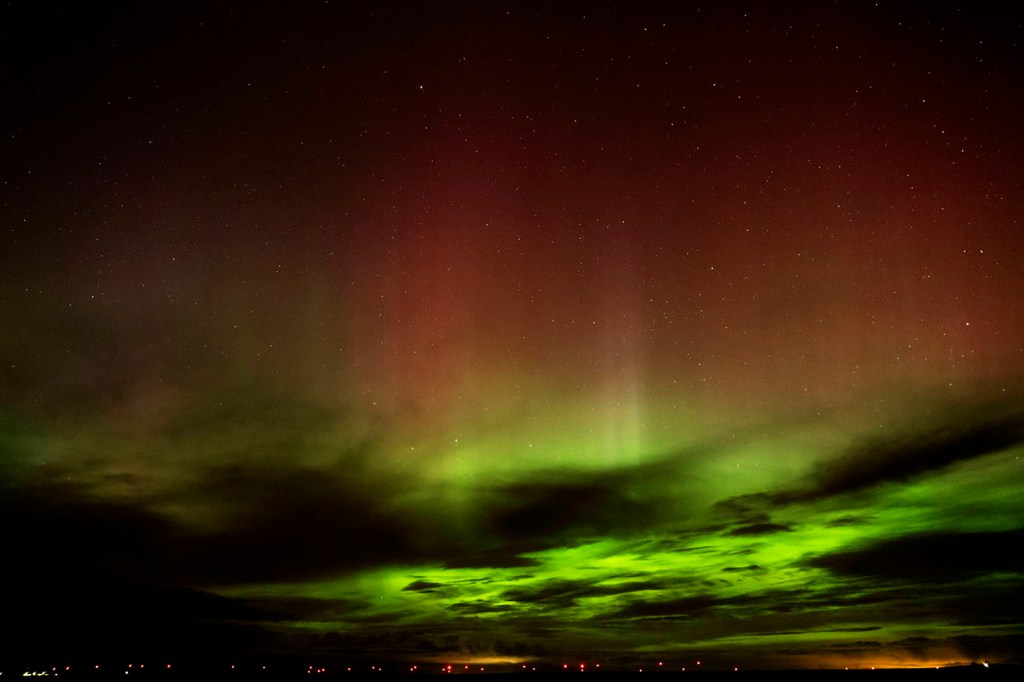Why you probably won’t see the Northern Lights in New England—despite early forecasts

The buzz around predictions that a spectacular display of Northern Lights would illuminate the night skies in 17 states this week is fizzling out.
It turns out that predicting the space weather conditions that would allow viewing of the lights, also known as the aurora borealis, south of Canada is notoriously tricky.
Earlier this week, media reports including Smithsonian magazine said information from the University of Alaska Fairbanks Geophysical Institute indicated clear skies could allow the lights to be visible in locations from Montana, Wisconsin, Vermont and even as far south as Annapolis, Maryland.
But now predictions are for the lights to dazzle, as usual, farther north.
The University of Alaska’s Geophysical Institute aurora forecast website said, as of Tuesday, that the aurora borealis would be seen above Juneau and Anchorage on Thursday, as well as low on the horizon in King Salmon, Alaska, and Port Rupert in British Columbia, Canada.
The news that streaming night colors of pink, green and purple likely won’t make their way southward is disappointing, says Jonathan Blazek, Northeastern assistant professor of physics.
But it’s not surprising.
Predicting auroras “is a notoriously hard problem,” he says. “It involves complex interactions between the sun’s magnetic field, the solar wind (all of the charged particles flying out from the sun), our magnetic field, and all of the charged particles that are already trapped near the earth.”
“They call it ‘space weather’ for a reason—it’s analogous to predicting where it will rain and how much. Pity your meteorologist, whether the forecast is local or not so local,” Blazek says.
How auroras are formed
Auroras are created when energized particles from the sun hit and get trapped by the earth’s magnetic field.
The light show happens when the particles escape into the atmosphere, typically around the north and south poles, and bounce into nitrogen and oxygen.
The different colors depend on where in the atmosphere the interaction is occurring and what elements are being “excited,” Blazek says.
Not only are the auroras more closely associated with the Arctic Circle and, in the case of Southern Lights or aurora australis, with Antarctica and New Zealand, they are more likely to be seen in winter when skies are darker for longer, Blazek says.
What ignited predictions of a spectacular display visible in the Lower 48 this week was the presence of a solar storm that was expected to drive the aurora farther south.
Solar storm
“Erratic and often very energetic bursts of solar wind” can allow the oval-shaped aurora to expand beyond its usual viewing distances, according to research associate professor Don Hampton, a space physicist at the Geophysical Institute at the University of Alaska Fairbanks.
“This sort of activity is what was predicted by NOAA for the coming week,” Hampton said in an emailed statement, adding that the Geophysical Institute gets its aurora forecast from NOAA’s Space Weather Prediction Center in Boulder, Colorado.
Models of space or planetary weather “typically have a wide range of predictions” since there are only a few satellites and instruments collecting data for them, Hampton said.
Once large solar storms leave the vicinity of the sun they cannot be tracked, which means “the final impact on earth’s magnetic field may be different than predicted,” he said.
Check the short-term forecast
An updated story in Smithsonian says some U.S. viewers may be able to see the aurora borealis from northern locations such as Portland, Maine; Lansing, Michigan; and Madison, Wisconsin.
People who want to make sure they don’t miss out on the possibility of viewing Northern Lights can check the Space Weather Prediction Center’s 30-minute aurora forecast.
The Geophysical Institute at the University of Alaska Fairbanks says that in Alaska the best time to view Northern Lights is around midnight, from 9 p.m. to 3 a.m.
Best viewing spots are north-facing beaches or hills with views of the far horizon, Blazek says. And of course earth conditions play a role, with clear skies offering the best view.
Cynthia McCormick Hibbert is a Northeastern Global News reporter. Email her at c.hibbert@northeastern.edu or contact her on Twitter @HibbertCynthia.







